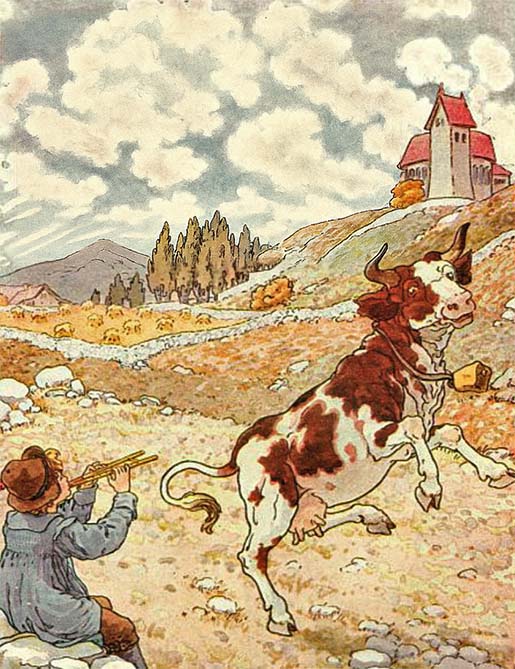There Was a Piper Had a Cow
There was a piper had a cow,
And he had naught to give her;
He pulled out his pipes and played her a tune,
And bade the cow consider.
The cow considered very well,
And gave the piper a penny,
And bade him play the other tune,
“Corn rigs are bonny.”

Origins
The rhyme first appeared in print in 1784, in the collection Gammer Gurton’s Garland. By then it was likely already a familiar ditty in Scotland, passed down in oral tradition. Early versions used Scots dialect words like “nocht” (nothing) and “spring” (tune), suggesting its roots lay north of the border.
 The Scottish flavor is unmistakable. Not only is the hero a piper — a symbol of Highland music — but the cow asks for “Corn Rigs are Bonny”, a real Scottish folk tune. Robert Burns himself wrote lyrics for “Corn Rigs” in the 1780s, so the reference would have been instantly recognizable to Scottish listeners.
The Scottish flavor is unmistakable. Not only is the hero a piper — a symbol of Highland music — but the cow asks for “Corn Rigs are Bonny”, a real Scottish folk tune. Robert Burns himself wrote lyrics for “Corn Rigs” in the 1780s, so the reference would have been instantly recognizable to Scottish listeners.
Different Versions
Over time, the rhyme split into two main versions.
-
The cheerful Mother Goose ending — the one we know best — has the cow pay the piper a penny and request “Corn Rigs are Bonny.” This form was widely reprinted in Victorian nursery books and eventually became standard.
-
The older Scots ending is more sardonic. In that version, the cow “considered wi’ hersel’” and declared:
“Gie me a pickle pease-strae,
And sell your wind for siller.”In plain English: “Give me a bit of pea-straw, and sell your breath (music) for money.” Instead of tipping the piper, the cow insists on real fodder and tells him to go earn a living with his pipes.
Some editors printed only the first four lines, leaving the cow’s reply hanging. This shows that the rhyme wasn’t fixed in form, but told and retold to suit the moment.
Meaning
At face value, it’s a comic scene. A poor piper has no feed for his cow, so he offers music instead. The cow pauses to “consider” and then, depending on the version, either rewards him with a penny or reminds him that a tune won’t fill her belly.
The Scots ending turns the rhyme into a witty fable about practicality vs. art. Music may be lovely, but cows can’t live on bagpipe tunes. The piper must convert his “wind” into money if he wants to keep his cow happy. It’s a down-to-earth lesson wrapped in absurd humor.
Even in the lighter version, the moral still peeks through. The cow does pay, but only for a specific song she likes. Art has value — but only if it pleases the audience.
The rhyme reflects a familiar rural world: pipers playing for their keep, farm animals central to survival, and folk tunes weaving through daily life. The notion of playing music for animals has an ancient pedigree, from Orpheus charming beasts in Greek myth to the Pied Piper. Here it’s turned into rustic comedy — a cow doubling as both critic and patron.
The request for “Corn Rigs are Bonny” anchors the rhyme in its time. “Corn rigs” means ridges of cut grain, and the old Scots tune celebrated harvest nights. Burns’ version made it even more popular. By having the cow ask for that song, the rhyme winked at listeners who knew it as a dance tune at country gatherings.
Interestingly, the English language also preserved an idiom about cows and music: “the tune the old cow died of.” It meant a dreary tune that dragged on forever. While not directly from this rhyme, it shows how people enjoyed linking cows with musical jokes.

